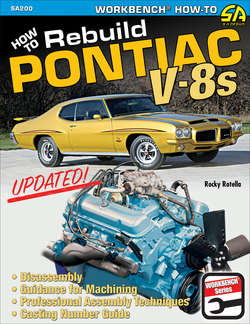Читать книгу How to Rebuild Pontiac V-8s - Updated Edition - Rocky Rotella - Страница 7
На сайте Литреса книга снята с продажи.
ОглавлениеFOREWORD
There are few objects in this world as beautiful to behold as a trimmed-out Pontiac V-8. With its light-blue paint, chrome valve covers and 4-barrel, or even better, three 2-barrel Rochester 2GC carbs sitting under three small chrome pots, it is truly a stunning sight—in my opinion, the best-looking car engine of all time.
Even more exciting than looking at a Pontiac V-8 is stomping on the throttle of one. I have had that pleasure many times over the years in the course of road-testing Pontiacs for various magazines, and in owning some. I’d had a few clunkers before, but my first real car was a 1959 Pontiac Bonneville convertible—Tri-Power, Royal Bobcat kit, and 4.55:1 gears. Later I bought a 1968 GTO—400 H.O., 4-speed, and 3.90:1 gears. I still own a 1976 Trans Am.
I can say with certainty that there is something unique about the wail of a Pontiac V-8 under full throttle. It starts out as a low moan. As the revs climb and the secondaries fully open, the sound changes to a banshee-like wail that promises to suck up and spit out any nearby competitor. It’s absolute music to an enthusiast’s ear.
Pontiac engines also possess inner beauty. For one thing, they’re relatively easy to work on. All the components are pretty much straightforward and easily bolt on and off. There are no tricks involved.
For another thing, they’re responsive. Want to build a Poncho that screams? That’s easy. Pontiac V-8s respond, and quite well, to just about any modification or improvement you wish to bestow upon them. All the usual stuff makes any Pontiac run better—increased carburetion, a hotter cam, headers, headwork, etc. You can hardly make a mistake if you’re working with a Pontiac.
Finally, there is the interchangeability. Just about any component from any year—heads, intake manifolds, camshafts, etc.—fits to just about any other year block. So, if you want to put a 1966 389 Tri-Power intake manifold on a 1970 400 block and use a number-068 H.O. cam from a 1968, go right ahead. It all works—and well. Thank you, Pontiac engine design engineers, wherever you are.
In this book, renowned Pontiac tech expert Rocky Rotella takes you through the ubiquitous 400 Pontiac V-8, from a stock rebuild with mild modifications that increases horsepower to nearly 400. But what he shows and tells you applies to your Pontiac engine too, be it a 1958 347 or a 1976 455. Rocky’s tech articles appear regularly in Pontiac publications such as High Performance Pontiac magazine and the Pontiac-Oakland Club International’s official mag, Smoke Signals. He knows Pontiacs. He knows his stuff. You’re in good hands with Rocky.
—Joe Oldham, author of Muscle Car Confidential
